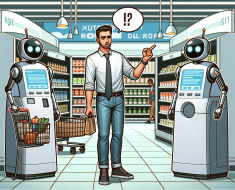In today’s fast-paced digital world, technology is increasingly becoming a part of our daily lives. One such groundbreaking technology is computer vision. This branch of artificial intelligence enables machines to interpret and understand visual information from the world around us. From improving our social media experiences to bolstering security measures, computer vision is transforming how we interact with technology and each other.
Computer Vision in Social Media


Social media platforms have become a staple in our daily routines, and computer vision plays a significant role in this space. One of the most visible uses is in image and video recognition. Platforms like Facebook and Instagram use computer vision algorithms to identify objects, places, and people in photos and videos. This technology powers features like automatic tagging of friends in photos, making it easier for us to share moments with our loved ones¹.
Moreover, computer vision aids content moderation on these platforms. Algorithms scan and analyze images and videos to detect inappropriate or harmful content, helping maintain a safe online environment². Augmented reality (AR) filters, popularized by apps like Snapchat, also rely on computer vision to detect facial features and overlay digital effects, allowing users to express themselves creatively¹.
Revolutionizing Retail with Computer Vision


Retailers are leveraging computer vision to improve customer experiences and streamline operations. In stores, this technology helps analyze customer behavior by tracking movement patterns and interactions with products³. This data enables retailers to optimize store layouts and personalize marketing strategies. Online shopping platforms also benefit from computer vision through enhanced product recommendations. By analyzing images of products you’ve viewed or purchased, algorithms suggest similar items you might like⁴. This personalization makes online shopping more engaging and efficient.
Advancing Healthcare Diagnostics


In the healthcare sector, computer vision is making strides in diagnostics and treatment planning. Medical imaging technologies like X-rays and MRIs use computer vision algorithms to detect abnormalities more accurately than traditional methods⁵. This advancement allows doctors to diagnose conditions earlier and with greater precision. Additionally, computer vision aids in developing prosthetics and other medical devices by analyzing patient-specific data to create customized solutions⁶. As this technology continues to evolve, it promises even more breakthroughs in healthcare.
Improving Security with Computer Vision


Security systems have significantly benefited from computer vision applications. Surveillance cameras equipped with this technology can detect movement, recognize faces, and even track suspicious activities in real-time⁷. This capability enhances public safety by allowing quicker responses to potential threats. Facial recognition technology is another crucial application in security systems. It identifies individuals in real-time for purposes ranging from unlocking smartphones to identifying suspects in criminal investigations⁸. However, while these advancements offer substantial benefits, they also raise privacy concerns that need careful consideration¹.
Driving Innovation in Autonomous Vehicles


Autonomous vehicles are one of the most exciting applications of computer vision. These self-driving cars rely on cameras and sensors to navigate their surroundings safely⁹. Computer vision algorithms process visual data from these devices to detect obstacles, read traffic signs, and make split-second decisions on the road⁹. This technology not only promises safer roads but also greater accessibility for those unable to drive due to age or disability¹⁰. As research progresses, we can expect autonomous vehicles to become a common sight on our streets.
Conclusion: The Future of Computer Vision
Computer vision is undoubtedly changing the way we live, work, and interact with technology. Its applications span various industries—from social media and retail to healthcare and security—demonstrating its versatility and potential for future innovations. As we continue integrating computer vision into our daily lives, it’s crucial to balance technological advancements with ethical considerations around privacy and security. By doing so, we can harness the full potential of this transformative technology while ensuring a safe and equitable future for all.
Citations
1. Balamurugan, Sundar. “Computer Vision in Social Media: Transforming Online Interactions.” LinkedIn Pulse, 13 July 2023.
2. “8 Real-World Applications of Computer Vision in 2023.” Augmented Startups Blog, 10 May 2023.
3. “Computer Vision in Practice: Real-World Applications in Life and Business.” Qtravel.ai Blog.
4. “Guide to Computer Vision Applications.” Scale AI Guide.
5. “Top 5 Real-World Applications of Computer Vision and Trends in 2023.” Omdena Blog.
6. “How Computer Vision Aids Prosthetics Development.” Omdena Blog.
7. “Computer Vision in CCTV: Revolutionizing Security and Surveillance Technology.” Visionplatform.ai.
8. “What Is Computer Vision? (Definition, Examples, Uses).” Built In.
9. “Computer Vision and Autonomous Vehicles: Navigating the Future.” Built In.
10. “Accessibility Benefits of Autonomous Vehicles with Computer Vision.” Built In.
Please note, that the author may have used some AI technology to create the content on this website. But please remember, this is a general disclaimer: the author can’t take the blame for any mistakes or missing info. All the content is aimed to be helpful and informative, but it’s provided ‘as is’ with no promises of being complete, accurate, or current. For more details and the full scope of this disclaimer, check out the disclaimer page on the website.





